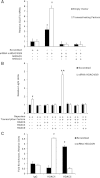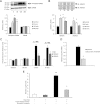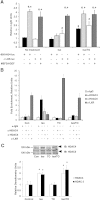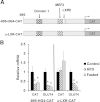Class II histone deacetylases downregulate GLUT4 transcription in response to increased cAMP signaling in cultured adipocytes and fasting mice
- PMID: 22403301
- PMCID: PMC3357296
- DOI: 10.2337/db11-0737
Class II histone deacetylases downregulate GLUT4 transcription in response to increased cAMP signaling in cultured adipocytes and fasting mice
Abstract
Insulin-mediated glucose uptake is highly sensitive to the levels of the facilitative glucose transporter protein, GLUT4. Repression of GLUT4 expression is correlated with insulin resistance in adipose tissue. We have shown that differentiation-dependent GLUT4 transcription was under control of class II histone deacetylases (HDACs). We hypothesized that HDACs may regulate gene expression in adipocytes as a result of adrenergic activation. To test this hypothesis, we activated cAMP signaling in 3T3-L1 adipocytes and in mice after an overnight fast. Chromatin immunoprecipitation experiments showed the association of HDAC4/5 with the GLUT4 promoter in vivo and in vitro in response to elevated cAMP. Knockdown of HDACs by small interfering RNA in cultured adipocytes prevented the cAMP-dependent decrease in GLUT4 transcription. HDAC4/5 recruitment to the GLUT4 promoter was dependent on the GLUT4 liver X receptor (LXR) binding site. Treatment of cells with an LXR agonist prevented the cAMP-dependent decrease in GLUT4 transcription. A loss of function mutation in the LXR response element was required for cAMP-dependent downregulation of GLUT4 expression in vitro, in fasted mice, and in mice subjected to diet-induced obesity. This suggests that activation of LXR signaling can prevent loss of GLUT4 expression in diabetes and obesity.
Figures







References
-
- Charron MJ, Katz EB, Olson AL. GLUT4 gene regulation and manipulation. J Biol Chem 1999;274:3253–3256 - PubMed
-
- Berger J, Biswas C, Vicario PP, Strout HV, Saperstein R, Pilch PF. Decreased expression of the insulin-responsive glucose transporter in diabetes and fasting. Nature 1989;340:70–72 - PubMed
-
- Garvey WT, Huecksteadt TP, Birnbaum MJ. Pretranslational suppression of an insulin-responsive glucose transporter in rats with diabetes mellitus. Science 1989;245:60–63 - PubMed
-
- Sinha MK, Raineri-Maldonado C, Buchanan C, et al. Adipose tissue glucose transporters in NIDDM. Decreased levels of muscle/fat isoform. Diabetes 1991;40:472–477 - PubMed
Publication types
MeSH terms
Substances
Grants and funding
LinkOut - more resources
Full Text Sources
Molecular Biology Databases

